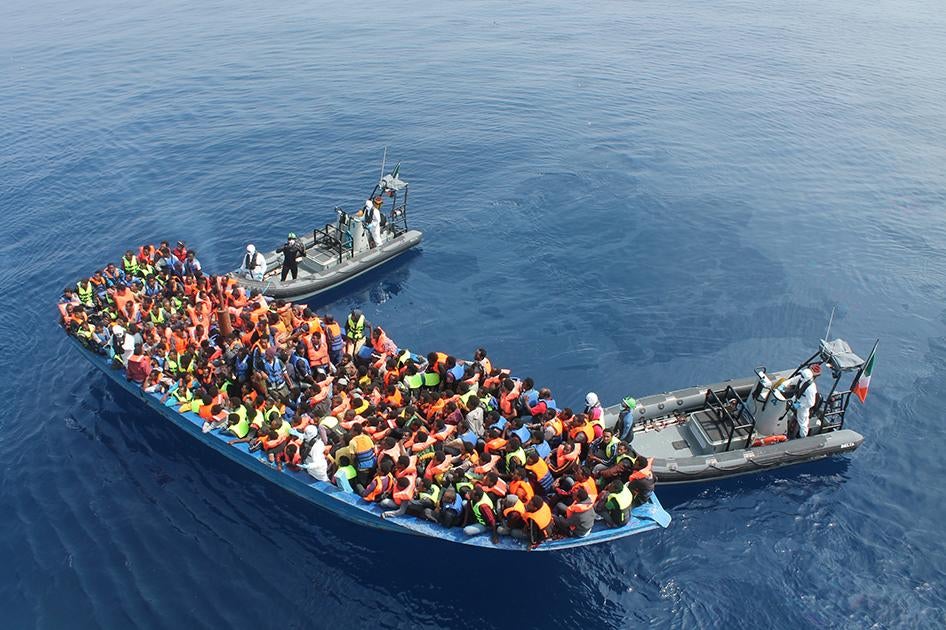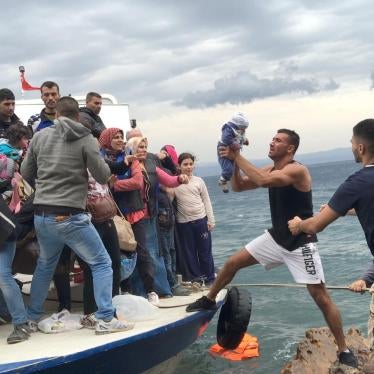The European Union (EU) is facing unprecedented numbers of refugees and migrants arriving by boat.
In 2014, 220,000 people arrived, almost double the combined total of 121,000 from 2011 through 2013. During just the first six months of 2015, 137,000 arrived, compared with 75,000 during the first six months of 2014. As seas are calmer during the summer months, many more are expected before the end of 2015.
The reaction in many EU countries has not been welcoming. In June, Prime Minister David Cameron of the United Kingdom said, “The vast majority of people setting off into the Mediterranean are not asylum seekers, but seeking a better life.” Cameron claims these are primarily economic migrants rather than people seeking refuge from war or persecution, though he has provided no evidence to support this claim.
So what does the available evidence say about why people risk their lives to reach the EU by boat?
Where do the majority of people arriving in the EU by boat come from originally?
According to the United Nations High Commissioner for Refugees (UNHCR), 66 percent of the 137,000 people who arrived in the EU between January 1 and June 29 were from five countries: Syria (34 percent), Afghanistan (12 percent), Eritrea (12 percent), Somalia (5 percent), and Iraq (3 percent). Almost all of them either set sail from North Africa and arrived in Italy, or left from Turkey and arrived in Greece.
Of those who arrived in Greece, 84 percent were from Syria, Afghanistan and Iraq, while just under half of those arriving in Italy were from Eritrea, Somalia and Syria. Significant other numbers of people arriving in Italy were from West African countries such Gambia and Nigeria, which generally produce more economic migrants than refugees.
Are the people from Syria, Afghanistan, Eritrea, Somalia, and Iraq economic migrants?
People are entitled to protection under international law if they fear a real risk of persecution or other serious harm in their home country.
Human Rights Watch, among other organizations, has long documented serious human rights abuses in these five countries, as well as generalized violence due to armed conflict in all but Eritrea. At the last count, these abuses had driven almost 25 million people from their homes, including almost 12 million Syrians, 4.2 million Iraqis, 3.6 million Afghans, 2.2 million Somalis, and almost half a million Eritreans. There is no doubt that the reasons these people leave their country and come to the EU are mixed, but there is also no doubt that their countries are embroiled in conflicts and widespread human rights abuses.
During the first half of this year, the 28 EU Member States recognized the overwhelming majority of nationals of these five countries who applied for asylum as refugees, or gave them some other protected status. The numbers are 95 percent of Syrians, 92 percent of Eritreans, 90 percent of Iraqis, 67 percent of Afghans, and 59 percent of Somalis.
There are no EU statistics that show how many of the people arriving by boat apply for asylum.
Since the people who finally were recognized as refugees in 2015 probably came to the EU in 2014 or before then, how do you know that those seeking asylum this year have the same protection needs?
Although it’s also impossible to know exactly how the trends will continue, there is no indication that the human rights situation has recently improved in any of those five countries, based on research by Human Rights Watch and other organizations. There is also every indication that the refugee flows from Syria, Iraq, Afghanistan, Eritrea, and Somalia will continue unabated in 2015.
But isn’t it possible that many of the people who need protection are also looking for jobs?
People fleeing persecution or other harm may have other reasons for leaving, including economic ones. But such reasons do not disqualify a person from being recognized as a refugee or given other types of protection. Refugee law only requires the person to show they fear a real risk of being harmed based on their race, religion, nationality, membership in a particular social group, or political opinion if they are forced to return to their country. International human rights law also prevents countries from returning people to a place where they face a real risk of torture or other prohibited ill-treatment, regardless of what other motivations they might have had for leaving.
What if people come to the EU after spending time in other countries where they were not persecuted or where they should have asked for protection? Doesn’t the fact that they move on show they are coming to the EU for economic reasons or work?
Afghan, Eritrean, Iraqi, Somali and Syrian nationals arriving in the EU by boat all have to pass through at least one other country where they had access to some level of help before reaching the EU. For example, some Eritreans pass through refugee camps in Ethiopia, and many Syrians lived for a while in refugee camps or urban centers in Turkey before heading to the EU.
It’s impossible to know all the factors, including personal and economic ones, that motivate each asylum seeker to move from his or her country of first asylum and through transit countries to reach the EU. The government of a receiving country can return an asylum seeker to a country of first asylum or transit if he or she has, or could have, enjoyed “effective protection” there.
Generally that means the county must be genuinely safe. More specifically it means the country must respect the principle of nonrefoulement, the prohibition on returning a person to a place where they risk persecution or other serious harm. The country must also have fair and efficient asylum procedures, and, for those found to need protection, show respect for their rights by providing residency documents, freedom of movement, and the right to work. The EU also needs to have a return agreement with the country concerned that it will meet those requirements before it can return anyone there.
Some of the countries where asylum seekers lived in or passed through before coming to the EU, including Lebanon, Jordan, and Libya, have not acceded to the 1951 Refugee Convention and have no refugee law which would require respect for these standards. Libya has a poor security situation with serious fighting between two rival governments and a track record of abuse of migrants and asylum seekers. Turkey has attached a limitation to its accession to the Refugee Convention that effectively excludes members of all of these five nationalities from recognition—and full legal protection—as refugees. Other key countries of first asylum and transit, such as Iran, Sudan, and Egypt, have not consistently demonstrated their ability or willingness to provide effective protection to all refugees even though they are parties to the Refugee Convention.
So what about economic migrants on the boats? What should happen to them?
EU governments have the right to return anyone arriving in the EU who does not claim asylum or whose protection claim is rejected under procedures respecting EU law to their country of origin. However, this must be done in a humane and rights-respecting manner that takes into account any family ties or humanitarian grounds that might argue against removal.









